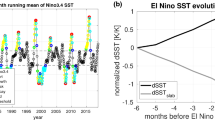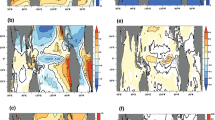Abstract
We analyze how the characteristics of El Niño-Southern Oscillation (ENSO) are changed in coupled ocean–atmosphere simulations of the mid-Holocene (MH) and the Last Glacial Maximum (LGM) performed as part of the Paleoclimate Modeling Intercomparison Project phase 2 (PMIP2). Comparison of the model results with present day observations show that most of the models reproduce the large scale features of the tropical Pacific like the SST gradient, the mean SST and the mean seasonal cycles. All models simulate the ENSO variability, although with different skill. Our analyses show that several relationships between El Niño amplitude and the mean state across the different control simulations are still valid for simulations of the MH and the LGM. Results for the MH show a consistent El Niño amplitude decrease. It can be related to the large scale atmospheric circulation changes. While the Northern Hemisphere receives more insolation during the summer time, the Asian summer monsoon system is strengthened which leads to the enhancement of the Walker circulation. Easterlies prevailing over the central eastern Pacific induce an equatorial upwelling that damps the El Niño development. Results are less conclusive for 21ka. Large scale dynamic competes with changes in local heat fluxes, so that model shows a wide range of responses, as it is the case in future climate projections.














Similar content being viewed by others
References
An SI, Timmermann A, Bejarano L, Jin F, Justino F, Liu Z (2004) Modeling evidence for enhanced El Niño-Southern Oscillation amplitude during the Last Glacial Maximum. Paleoceang 19:4009. doi:10.1029/2004PA001020
Battisti DS, Hirst AC (1989) Interannual variability in a tropical atmosphere–ocean model: influence of the basic state, ocean geometry and nonlinearity. J Atmos Sci 46:1687–1712
Berger AL (1978) Long-term variations of caloric insolation resulting from the earth’s orbital elements. Q Res 9:139–167
Bjerknes J (1969) Atmospheric teleconnections from the equatorial Pacific. Mon Weather Rev 97:163–172
Braconnot P, Marti O, Joussaume S, Leclainche Y (2000) Ocean Feedback in Response to 6 Kyr BP Insolation. J Clim 13:1537–1553
Braconnot P, Otto-Bleisner BL, Harrison S, Joussaume J, Peterschmitt JY, Abe-Ouchi A, Crucifix M, Fichefet, Hewitt C, Kageyama M, Kitoh A, Laîné A, Loutre MF, Marti O, Merkel U, Ramstein G, Valdes P, Weber L, Yu Y, Zhao Y (2007a) Results of Pmip2 coupled simulations of the mid-Holocene and Last Glacial Maximum—Part 1: Experiments and large-scale features. Clim Past 3(2):261–277
Braconnot P, Otto-Bleisner BL, Harrison S, Joussaume J, Peterschmitt JY, Abe-Ouchi A, Crucifix M, Fichefet, Hewitt C, Kageyama M, Kitoh A, Loutre MF, Marti O, Merkel U, Ramstein G, Valdes P, Weber L, Yu Y, Zhao Y (2007b) Results of Pmip2 coupled simulations of the mid-Holocene and Last Glacial Maximum—Part 2: Feedbacks with emphasis on the location of the ITCZ and mid- and high latitudes heat budget. Climate of the Past 3(2):279–296
Braconnot P, Hourdin F, Bony S, Dufresne JL, Grandpeix JY, Marti O (2007c) Impact of different convective cloud schemes on the simulation of the tropical seasonal cycle in a coupled ocean–atmosphere model. Clim Dyn. doi:10.1007/s00382–007–0244-y
Brown J, Collins M, Tudhope A, Toniazzo T (2007) Modelling mid-Holocene tropical climate and ENSO variability: towards constraining predictions of future change with palaeo-data. Clim. Dyn. doi:10.1007/s00382–007-0270-9
Chang P (1996) The role of the dynamic ocean-atmosphere interactions in tropical seasonal cycle. J Clim 9:2973–2985
Chang P, Ji L, Wang B, Li T (1995) Interaction between the seasonal cycle and El Niño-Southern oscillation in an intermediate coupled ocean–atmosphere model. J Atmos Sci 52:2353–2372
Clement AC, Seager R, Cane MA, Zebiak SE (1996) An ocean dynamical thermostat. J Clim 9:2190–2196
Clement AC, Seager R, Cane MA (1999) Orbital controls on the El Niño/Southern Oscillation and the tropical climate. Paleoceanog 14:441–456
Clement AC, Seager R, Cane MA (2000) Suppression of El Niño during the mid-Holocene by changes in the Earth’s orbit. Paleoceanog 15:731–737
Cole J (2001) A slow dance for El Niño. Science 291:1461–1497
Collins WD, Bitz CM, Blackmon ML, Bonan GB, Bretherton CS, Carton JA, Chang P, Doney SC, Hack JJ, Henderson TB, Kiehl JT, Large WG, McKenna DS, Santer BD, Smith RD (2006) The community Climate System Model Version 3 (CCSM3). J Clim 19:2122–2143
Fedorov AV, Philander SG (2001) A stability analysis of tropical ocean–atmosphere interactions: bridging measurements and theory for El Niño. J Clim 14:3086–3101
Gill AE (1982) Atmosphere–Ocean dynamics. Academic, San Diego
Goswami BN, Krishnamurthy V, Annamalai H (1999) A broad-scale circulation index for the interannual variablity of the Indian summer monsoon. Q J R Meteorol Soc 125:611–633
Gu D, Philander SG (1995) Secular changes of annual and inter-annual variability in the tropics during the past century. J Clim 8:864–876
Guilyardi E (2006) El Niño-mean state-seasonal cycle interactions in a multi-model ensemble. Clim Dyn 26:329–348, doi:10.1007/s00382-005-0084-6
Harrison SP, Braconnot P, Joussaume S, Hewitt C, Stouffer RJ (2002) Fourth international workshop of The Palaeoclimate Modelling Intercomparison Project (PMIP): launching PMIP Phase II. EOS 83:447
Jacob RL, Schafer C, Foster I, Tobis M, Anderson J (2001) Computational Design and performance of the fast ocean-atmosphere model, ver. 1. In: Alexandrov VN, Dongarra JJ, Juliano BA, Renner RS, Tan CJK (eds) Proceedings of the international conference on computational science (ICCS), LNCS 2073. Springer, Heidelberg, pp175–184
Jin FF (1997) An equatorial ocean recharge paradigm for ENSO. Part I: conceptual model. J Atmos Sci 54:811–829
K-1 model developers (2004) K-1 coupled model (MIROC) description. Technical Report 1, Center for Climate System Research, University of Tokyo
Kistler R, Kalnay E, Collins W, Saha S, White G, Woollen J, Chelliah M, Ebisuzaki W, Kanamitsu M, Kousky V, van den Dool H, Jenne R, Fiorino M (2001) The NCEP-NCAR 50-year reanalysis: monthly means CD-ROM and documentation. Bull Am Meteorol Soc 82:247–267
Koutavas A, Lynch-Stieglitz J, Marchitto THJ, Sachs JP (2002) El Niño-like pattern in ice age tropical Pacific sea surface temperature. Science 297:226–230
Latif M, Sperber K, Arblaster J, Braconnot P, Chen D, Colman A, Cubasch U, Cooper C, Delecluse P, DeWitt D, Fairhead L, Flato G, Hogan T, Ji M, Kimoto M, Kitoh A, Knutson T, Le Treut H, Li T, Manabe S, Marti O, Mechoso C, Meehl G, Power S, Roeckner E, Sirven J, Terray L, Vintzileos A, Voss R, Wang B, Washington W, Yoshikawa I, Yu J, Zebiak S (2001) Ensip: The El Nino Simulation Intercomparison Project. Clim Dyn 18:255–276
Lea DW, Pak DK, Spero HJ (2000) Climate impact of Late Quaternary equatorial Pacific sea surface temperature variations. Science 289:1719–1724
Liu Z, Kutzbach J, Wu L (2000) Modeling climate shift of El Niño variability in the Holocene. Geophys Res Lett 27:2265–2268
Liu Z, Brady E, Lynch-Steiglitz J (2003) Global ocean response to orbital forcing in the Holocene. Paleoceanograpgy 18(2):1041. doi:10.1029/2002PA00819
Liu ZY, Shin SI, Webb RS, Lewis W, Otto-Bliesner BL (2005) Atmospheric CO2 forcing on glacial thermohaline circulation and climate. Geophys Res Lett 32(2):L02706
Marti O et al (2005) The new IPSL climate system model: IPSL-CM4. Technical report, Institut Pierre Simon Laplace des Sciences de l’Environnement Global IPSL Case101 4 place Jussieu Paris France
Otto-Bliesner BL, Brady EC, Shin SI, Liu Z, Shields C (2003) Modeling El Niño and its tropical teleconnections during the last glacial-interglacial cycle. Geophys Res Lett 30(23):2198. doi:10.1029/2003GL018553
Peltier WR (2004) Global glacial isostasy and the surface of the ice-age Earth: the ICE-5G (VM2) model and GRACE. Annu Rev Earth Planet Sci 32:111–149. doi:10.1146/annurev.earth.32.082503.144359
Rasmusson EM, Carpenter TH (1982) Variations in tropical sea surface temperature and surface wind fields associated with the Southern Oscillation/El Niño. Mon Weather Rev 110:354–384
Rayner N, Parker D, Horton E, Folland C, Alexander L, Rowell D, Kent EC, Kaplan A (2003) Global analyses of sea surface temperature, sea ice, and night marine air temperature since the late nineteenth century. J Geophys Res 108:4407. doi:10.1029/2002JD002670
Rodbell DT, Seltzer GO, Anderson DM, Abbott MB, Enfield DB, Newman JH (1999) An 15000-year record of El Niño-driven alleviation in southwestern Ecurador. Science 283:1516–1519
Shin SI, Liu Z, B. Otto-Bliesner L, Brady EC, Kutzbach JE, Harrison SP (2003) A simulation of the Last Glacial Maximum Climate using the NCAR CSM. Clim Dyn 20:127–151
Sun DZ, Liu ZY (1996) Dynamic ocean–atmosphere coupling: a thermostat for the tropics. Science 272:1148–1150
Wang C, Picaut J (2004) Understanding ENSO Physics—a review. In: Wang C, Xie SP, Carton JA (eds) Earth’s climate: the ocean–atmosphere interaction. Geophysical Monograph Series, AGU, Washington DC, pp 21–48
Wu G, Meng W (1998) Gearing between the Indo-monsoon circulation and Pacific Walker circulation and ENSO I: Data analyses (in Chinese). Chin J Atmos Sci 22:470–480
Yukimoto S, Noda A (2002) Improvements of the Meteorological Research Institute Global Ocean–atmosphere Coupled GCM (MRI-CGCM2) and its climate sensitivity. Tech Report10 NIES Japan
Yu Y, Yu R., Zhang X, Liu H (2002) A flexible global coupled climate model. Adv Atmos Sci 19:169–190
Yu Y, Zhang X, Guo Y (2004) Global coupled ocean–atmosphere general circulation models in LASG/IAP. Adv Atmos Sci 21:444–455
Zebiak SE, Cane MA (1987) A model El Niño-Southern Oscillation. Mon Weather Rev 115:2262–2278
Zhao Y, Braconnot P, Harrison SP, Yiou P, Marti O (2007) Simulated changes in the relationship between tropical ocean temperatures and the western African monsoon during the mid-Holocene. Clim Dyn 28:533–551
Acknowledgment
This study is jointly supported by National Natural Science Foundation of China (NSFC) grant (No. 40675049) and China basic research project “Ocean Carbon Cycle and Tropical Forcing of Climate Evolution” (No. 2007CB815900). Dr. Weipeng Zheng also benefits from a support by PRA to spent 4 months at LSCE to start this work. We acknowledge the international modeling groups for providing their data for analysis, the Laboratoire des Sciences du Climat et de l’Environnement (IPSL/LSCE) for collecting and archiving the model data. The PMIP2/MOTIF Data Archive is supported by CEA, CNRS, the EU projects MOTIF (EVK2-CT-2002–00153) and the Programme National d’Etude de la Dynamique du Climat (PNEDC). This work is also a contribution to the EU project DYNAMITE (GOCE #003903). The analyses were performed using version 10/01/2006 of the database. More information is available on http://www-lsce.cea.fr/pmip2/ and http://www-lsce.cea.fr/motif/.
Author information
Authors and Affiliations
Corresponding author
Rights and permissions
About this article
Cite this article
Zheng, W., Braconnot, P., Guilyardi, E. et al. ENSO at 6ka and 21ka from ocean–atmosphere coupled model simulations. Clim Dyn 30, 745–762 (2008). https://doi.org/10.1007/s00382-007-0320-3
Received:
Accepted:
Published:
Issue Date:
DOI: https://doi.org/10.1007/s00382-007-0320-3




